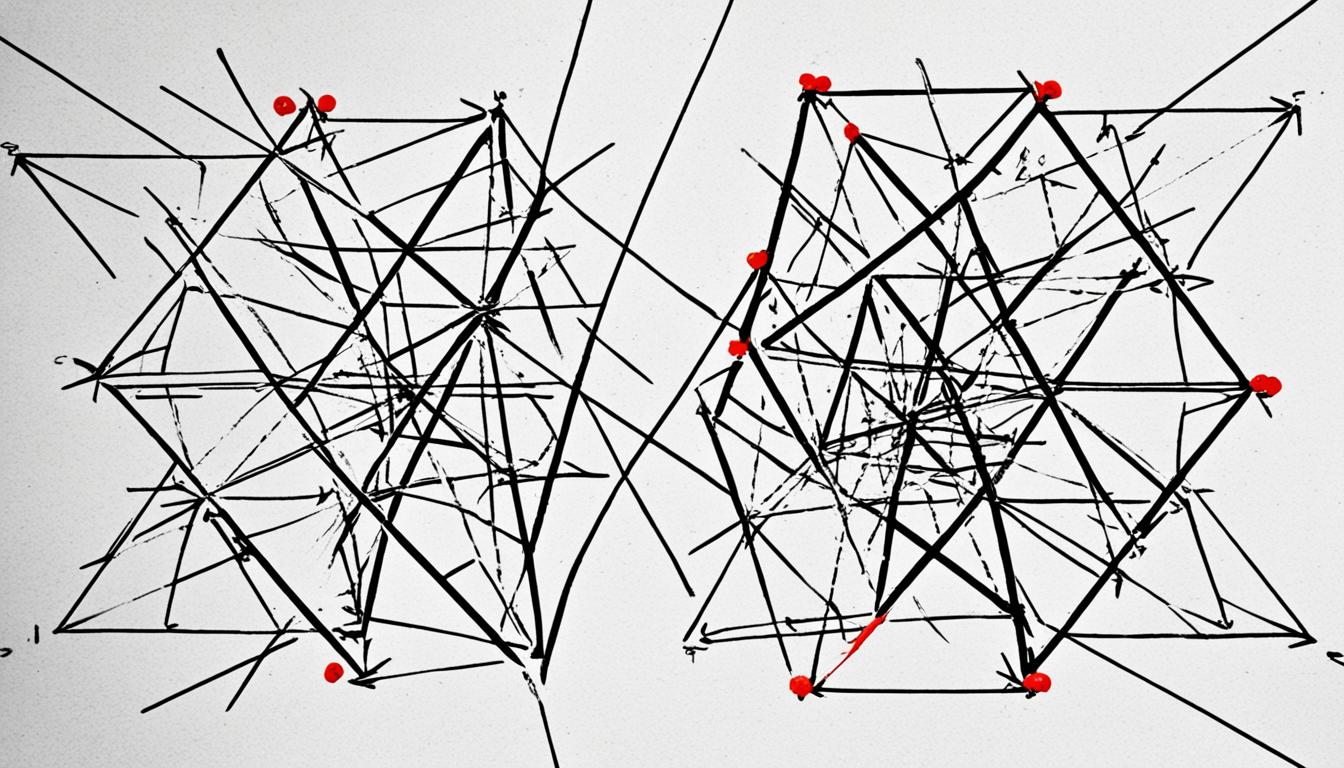Welcome to our comprehensive guide on corresponding angles! In this article, we will unravel the intricacies of corresponding angles, explore their definitions, and shed light on the corresponding angles theorem. Whether you’re a student of geometry or simply curious about this geometric concept, you’ve come to the right place.
Corresponding angles are a fundamental aspect of geometry, particularly when dealing with parallel lines and transversals. By understanding the properties and relationships of corresponding angles, you’ll gain valuable insights into the world of angles and geometry.
Key Takeaways:
- Corresponding angles are pairs of angles formed when a transversal intersects two lines.
- They are located in corresponding positions on the same side of the transversal, with one angle inside the two lines and the other outside.
- The corresponding angles theorem states that if two parallel lines are intersected by a transversal, then the corresponding angles created are congruent.
- Understanding corresponding angles is essential for proving the alternate interior angles theorem and the same-side interior angles theorem.
- Practice identifying corresponding angles using available worksheets to reinforce your knowledge.
Defining Corresponding Angles
Let’s start by defining corresponding angles. Corresponding angles are a pair of angles that are formed when a transversal intersects two lines. These angles are located in corresponding positions on the same side of the transversal, with one angle inside the two lines and the other outside.
To better visualize corresponding angles, imagine two parallel lines being intersected by a transversal. As shown in the diagram below:
The angles highlighted in red are the corresponding angles. They are identified by their positions relative to the transversal and the parallel lines. In this case, the corresponding angles are in the top left and bottom right positions.
When discussing corresponding angles, it’s important to note that they are always congruent when the lines are parallel. This property is known as the corresponding angles theorem. We will explore the corresponding angles theorem in more detail in the next section.
Understanding the Corresponding Angles Theorem
The corresponding angles theorem is a fundamental concept in geometry that plays a crucial role in understanding the properties of parallel lines. This theorem states that when a transversal intersects two parallel lines, the corresponding angles formed are congruent.
Let’s take a closer look at this theorem:
“If two parallel lines are intersected by a transversal, then the corresponding angles created are congruent.”
This means that if we have two parallel lines, and a line intersects them in such a way that it creates angles on either side of the intersection, the corresponding angles will be equal in measure.
In the image above, the transversal line intersects two parallel lines, creating several angles. The corresponding angles are labeled with the same letters (a, b, c, d), indicating that they have equal measures.
This theorem is extremely useful when solving various angle-related problems in geometry. By recognizing corresponding angles and their congruence, we can make accurate calculations and deductions.
Now that we understand the corresponding angles theorem, let’s explore some practical examples to solidify our understanding.
Exploring Examples of Corresponding Angles
To better understand corresponding angles, let’s explore some examples. By analyzing scenarios where parallel lines are intersected by a transversal, we can identify corresponding angles and deepen our comprehension of this geometric concept.
Example 1: Parallel Lines with a Transversal
Consider the figure below, where line a and line b are parallel, and line c intersects them as a transversal:

According to the corresponding angles theorem, ∠1 and ∠2 are corresponding angles, and they are congruent.
Example 2: Corresponding Angles in a Z-Shape
In the figure below, we observe two parallel lines, line d and line e, intersected by transversal line f:

Here, ∠3 and ∠4 are corresponding angles, and since they are on the same side of the transversal, they are congruent.
These examples highlight how corresponding angles appear in different arrangements of parallel lines and transversals. By identifying and understanding these angles, you can approach geometry problems with confidence and accuracy.
Applications of Corresponding Angles in Geometry
In geometry, corresponding angles play a crucial role in proving various theorems and solving problems. They provide valuable insights into the relationships between lines and angles, allowing us to analyze geometric shapes with precision. Understanding the applications of corresponding angles in geometry is essential for mastering this fundamental concept.
Proving Theorems
Corresponding angles are used to prove significant theorems in geometry. Two essential theorems that rely on the concept of corresponding angles are the Alternate Interior Angles Theorem and the Same-Side Interior Angles Theorem. These theorems are widely applicable and provide critical insights into the properties of intersecting lines and angles.
The Alternate Interior Angles Theorem states that when two parallel lines are cut by a transversal, the pairs of alternate interior angles are congruent.
The Same-Side Interior Angles Theorem states that when two parallel lines are cut by a transversal, the pairs of same-side interior angles are supplementary.
Analyzing Geometric Shapes
By understanding corresponding angles, we can analyze geometric shapes and determine various properties. Whether it’s identifying congruent angles in similar figures or determining the angles of intersecting lines, knowledge of corresponding angles allows us to make precise calculations and draw accurate conclusions about geometric shapes.
Solving Problems Involving Parallel Lines
Problems involving parallel lines often require the utilization of corresponding angles. By recognizing and applying the properties of corresponding angles, we can solve complex problems related to parallel lines, transversals, and their associated angles. This skill is invaluable when working with geometric proofs or practical applications of geometry.
Comparing Corresponding Angles with Other Angle Pairs
| Angle Pair | Definition | Property |
|---|---|---|
| Corresponding angles | A pair of angles formed by a transversal intersecting two parallel lines on the same side of the transversal | If the lines are parallel, corresponding angles are congruent |
| Alternate interior angles | A pair of nonadjacent angles formed by a transversal intersecting two parallel lines | If the lines are parallel, alternate interior angles are congruent |
| Same-side interior angles | A pair of angles formed by a transversal intersecting two parallel lines on the same side of the transversal | If the lines are parallel, same-side interior angles are supplementary |
In conclusion, corresponding angles serve as a foundational concept in geometry, enabling us to prove theorems, analyze geometric shapes, and solve problems involving parallel lines. This understanding helps us unlock the intricacies of geometry and develop valuable problem-solving skills. By mastering the applications of corresponding angles, you’ll enhance your ability to navigate the world of geometry with confidence.
Conclusion
In conclusion, corresponding angles play a crucial role in geometry, especially when studying parallel lines and transversals. By understanding the definitions, theorem, and examples discussed in previous sections, you now have the knowledge and confidence to identify and work with corresponding angles effectively.
To further enhance your understanding and reinforce your learning, there are numerous corresponding angles worksheets available. These worksheets provide valuable practice exercises that allow you to apply your knowledge and strengthen your skills in identifying and solving problems involving corresponding angles.
Working through corresponding angles worksheets not only helps solidify your conceptual understanding but also improves your ability to apply this knowledge in practical situations. By practicing with different scenarios and varied problem sets, you can refine your proficiency and become more adept at handling corresponding angles in complex geometric situations.
So, if you want to excel in geometry and master the intricacies of corresponding angles, make sure to utilize the available corresponding angles worksheets. With consistent practice and dedication, you will become a proficient problem solver, ready to tackle any geometry challenge that comes your way.
FAQ
What are corresponding angles?
Corresponding angles are a pair of angles that are formed when a transversal intersects two lines. They are located in corresponding positions on the same side of the transversal, with one angle inside the two lines and the other outside.
What is the corresponding angles theorem?
The corresponding angles theorem states that if two parallel lines are intersected by a transversal, then the corresponding angles created are congruent.
How can I identify corresponding angles?
To identify corresponding angles, look for pairs of angles that are in the same position on both sides of the transversal, but on opposite sides of the two lines.
How are corresponding angles used in geometry?
Corresponding angles have practical applications in geometry. They are used to prove various theorems, analyze geometric shapes, and solve problems involving parallel lines.
Can you provide some examples of corresponding angles?
Sure! In the diagram where line AB is parallel to line CD, if line EF is the transversal, then angle AEF and angle CEF are corresponding angles, as well as angle BEF and angle DEF.
Where can I find corresponding angles worksheets to practice?
There are numerous corresponding angles worksheets available online for additional practice and reinforcement. A simple internet search will provide you with a wide range of options.










